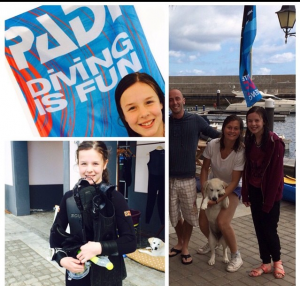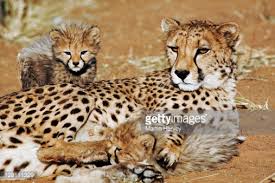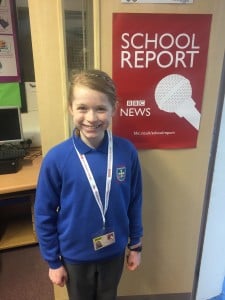 When I was age 8 for my birthday I got the chance to do a bubble maker scuba diving session to see if I liked it or not. It was all in a pool (not the North Sea!) and I did loads of things you would do in scuba diving e.g. Inflating my bcd (buoyancy control device), cleaning my mask, taking out my regulator and putting it back in and loads more. After that session my teacher told me I was a natural which made me want to do it again.
When I was age 8 for my birthday I got the chance to do a bubble maker scuba diving session to see if I liked it or not. It was all in a pool (not the North Sea!) and I did loads of things you would do in scuba diving e.g. Inflating my bcd (buoyancy control device), cleaning my mask, taking out my regulator and putting it back in and loads more. After that session my teacher told me I was a natural which made me want to do it again.
On my 10th birthday I was finally able to do my PADI qualification scuba course and I was so excited about it but unfortunally I couldn’t just go straight ahead and be a scuba diver: I had to do a 6 week course training to be one. I was given an open water scuba diving manual, log book, instructions for diving table and a scuba diving DVD to help me. After every week I did a test in my booklet and a pool test as well.
At the end of the 6 weeks I did a big test on everything to see what I had learned and I got 92% out of 100% which meant I could become a qualified scuba diver! However, I couldn’t become one just yet until I had completed four dives in the sea so I went to Madeira to do this. I was trained by a lady called Esther at Azul dive centre. She was really nice and taught me so well! After every dive I wrote in my log book about how deep we went down and what I saw. I really enjoyed doing the sea tests and on the fourth test I got to jump off a really high pier into the water doing a giant stride! It felt amazing getting told I was able to become a qualified scuba diver and getting my picture sent away to be printed on a card saying I was a qualified scuba diver!
By Jasmine, age 12.
 We wanted to ask some teachers what they would take with them if they had to move to another planet.
We wanted to ask some teachers what they would take with them if they had to move to another planet.
What item would you take if you had to move to another planet and why?
Mrs Irving: I would take a bike so that I could get around.
Mr Skinner: I would take a Swiss army knife to help me survive.
Miss Mckenzie: I would take photos so that I had memories to look back on.
Name one food item you would take?
Mr Hutchinson: My mum’s beef casserole!
Mr Storey: Lamb tikka madras.
Mrs Irving: A live chicken.
Name one drink would you like to take?
Miss Jackson: Diet American cream soda.
Mr Storey: Irn-Bru.
Which person would you like to take?
Mr Storey: My fiancé.
Mr Ord: Mr Storey!
Miss Mckenzie: My sister.
By Grace and Lexie, age 10 and 9.
 Endangered animals are animals that are under threat from habitat destruction or environment destruction. Some animals are also hunted for their ivory, skin or bones.
Endangered animals are animals that are under threat from habitat destruction or environment destruction. Some animals are also hunted for their ivory, skin or bones.
Black rhinos are constantly hunted for their ivory. Even in national parks, the rangers are constantly keeping an eye on the amount of black rhinos and looking out for people that could be poachers.
The WWF (World Wildlife Foundation) have put endangered animals into categories. These are: Critically Endangered, Endangered, Vulnerable, Near Threatened and Least Concern (WWF). Here are some examples of each:
- Critically Endangered: Black Rhino, South China Tiger, and Mountain Gorilla.
- Endangered: Asian Elephant, Chimpanzee, Blue Whale, and Giant Panda.
- Vulnerable: African Elephant, Great White Shark, Polar Bear, and Hippopotamus.
- Near Threatened: White Rhino, Jaguar, and Yellow Fin Tuna.
- Least Concern: Common Bottlenose Dolphin, Gorilla, Sloth.
These are only some of each category.
Here are some ways you can help the environment and the endangered animals:
Use less water
Using less hot water can help protect the environment as you will be using less energy. Using cold or warm water will wash your clothes just as well!
Turn off your lights!
Most of the energy from light bulbs is given off as heat, not light! Some light bulbs are four times more efficient than others so you should try to get these.
Recycle
You can recycle many things such as: paper, coloured paper, some food packaging, catalogues and lots more! You can’t recycle all papers though. Wrapping paper cannot be recycled so try to cut down on it over Christmas and find more friendly alternatives!
I have been to see some of these animals in the wild and I think it’s really important to keep them safe any way that we can.
By Lucy, age 12.
I’ve asked a few students from years 5 to 8 what they are thinking about for their future. Have they thought about what jobs they’d like to do and whether they want to go to university or not? Here’s what they said:
“When I am older I would like to be an agricultural solicitor. I live on a farm and I am interested in agriculture and I like listening to people and giving them advice. I am not sure what university I want to go to yet but I am going to think about it.” Rebecca, age 11.
“When I am older I want to be a seller at a sheep mart because my dad is a farmer and I’d like to follow in his footsteps. I’d also quite like to be a dancer and go to Cheltenham University to study dance.” Lexie, age 9.
“When I am older I would like to go to Oxford or Cambridge University and would like to study English, Maths and Music. I don’t know what I want to be when I am older, but I definitely want to go to university.” Georgia, age 9.
“When I am older I would like to go to University and study English and History because I really enjoy those subjects. I’m unsure what I want to do for a job at the moment.” Lucy, age 12.
Hermione, age 9.
 Some people think it is a disease. Some people do not know what to think of it. But we know what it is: it is a skin condition, fragile skin. I have EB and I and my friend Alice are going to tell you all about it.
Some people think it is a disease. Some people do not know what to think of it. But we know what it is: it is a skin condition, fragile skin. I have EB and I and my friend Alice are going to tell you all about it.
Epidermolysis Bullosa (EB) is a group of genetic skin conditions which causes the skin to blister at the slightest touch. There are three main types of EB: Simplex EB (which I have), Dystrophic and Junctional EB which are worse. Simplex is the mildest and Junctional is the worst.
Blisters are formed by friction or small rips to the skin. They are like balloons that fill with water apart from the water is fluid and the balloon is skin. It gets bigger and bigger until it gets popped with a special needle.
Simplex EB is the most common form of EB with 70% of the people with EB were diagnosed with Simplex. It typically forms itself a blistering itself to the hands and feet. In another of simplex skin blisters can occur all over the body. As you get older, the blisters don’t occur as much as you know what causes the blisters (seams in clothes and rough surfaces) and you can avoid this from happening (wearing seam-free clothes under seamy t-shirts or just in general).
Dystrophic EB is the second most common with 20% of the people with EB being diagnosed with it. It can be inherited (like Simplex) or not. When the blisters heal, it can leave scarring leading to contraction to the joints and narrowing of the oesophagus. Often the inherited type of Dystrophic EB is less severe and it can lead to an almost normal life. Of course it won’t completely heal. People with Dystrophic EB have a high chance of developing skin cancer before the age of 35, this can be quite frightening for people with this type of EB.
Junctional EB is, of course, the least common type with only 10% of the people suffering with EB have it. It is the most severe type of EB as it is fatal in infancy as only few babies survive past their third year; therefore this is a life-threatening condition. The milder form of Junctional EB isn’t life threatening however it can cause life-long pain and a disability.
dEBra is a charity that helps support families that have EB and they also do some amazing research. They give families advice and organise events so families with EB can come together and meet up.
My name is Rebecca and I have Simplex EB. My skin is getting better each year but I still do everything that is necessary. 1-2 times a day, my mum checks my skin and pops any blisters that has formed during the course of the day/night. After she has popped the blisters, she applies some cream to the skin to help the skin. I wear seam-free t-shirts under my school uniform and at the weekend I wear seam-free clothes. Every year I go to London, to Great Ormand Street Hospital, to get a check-up and gat advice from the dermatology department.
Thank you for reading. I hope this has given you a brief idea about Epidermolysis Bullosa.
Rebecca and Alice (Year 6)

